Weddings in Romania
Guided by their Erasmus+ ”Folklorica” project school coordinator, Mrs. Gabriela Mirela Jugar, Alina Rotariu and Cristina Feldorean, two pupils in ”Constantin Noica” High School, Sibiu, Romania, have made a research about weddings in Romania, the country where family is very important and where weddings are extremely important social events. They have written a text, added here in PDF format, with photos related to these events. In this material, the two pupils showed that the wedding traditions and customs differ from region to region and sometimes even from family to family, as while the true traditional weddings (which are usually organized in villages or smaller towns) are still organized according to old customs, urban Romanians sometimes tend to make the event as simple as possible, while keeping some simplified traditions. There are references to the days when usually a Romanian wedding takes place, to the periods of the year when there are no weddings, to the godparents’ big role in all the planning of a wedding, to the traditional bridal cake broken over the bride’s head and its pieces given to the guests, to the religious ceremony, as well as to customs and traditions, one the most popular tradition being in Romania the kidnapping of the bride. The superstitions related to the event were not forgotten either.
Mircea Dorca, teacher in ”Constantin Noica” High School Sibiu
Weddings in Romania.pdf
Nunțile din Romania
Ghidați de coordonatoarea proiectului Erasmus+ „Folklorica”, doamna Gabriela Mirela Jugar, Alina Rotariu și Cristina Feldorean, două eleve ale Liceului „Constantin Noica”, Sibiu, România, au făcut cercetări despre nunțile în România, țara unde familia este foarte importantă și unde nunțile sunt evenimente sociale extrem de importante. Ele au scris un text, l-au adăugat aici în format PDF, cu fotografii legate de aceste evenimente. În acest material, cele două eleve au arătat că tradițiile și obiceiurile de nuntă diferă de la o regiune la alta și uneori chiar de la familie la familie, căci, în timp ce adevăratele nunți tradiționale (care sunt de obicei organizate în sate sau orașe mai mici) sunt încă organizate în funcție de vechi obiceiuri, românii din mediul urban tind uneori să facă evenimentul cât se poate de simplu, păstrând în același timp câteva tradiții simplificate. Există referiri la zilele în care are loc de obicei o nuntă românească, la perioadele anului în care nu există nunți, la rolul mare al nașilor în toată planificarea unei nunți, la tradiționala turtă a miresei ruptă deasupra capul ei și bucățelele turtei dăruite oaspeților, la ceremonia religioasă, precum și la obiceiuri și tradiții, una dintre cele mai populare tradiții fiind în România răpirea miresei. Nu au fost uitate nici superstițiile aferente evenimentului.
Alina Mihoc, profesor, Liceul ”Constantin Noica” Sibiu, România
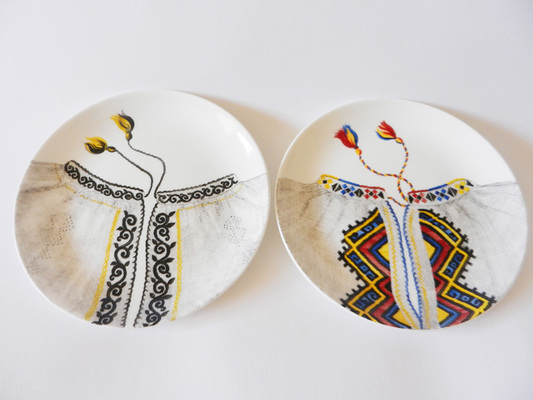
Turkish Wedding Traditions
Four pupils of the Erasmus+ project team prepared in a PDF document we posted here descriptions of wedding traditions in Turkey. Among them, we mention: the importance of marriage on human life and society, different kinds of marriage, the age of marriage, the agreement to marry, the engagement, the wedding, as well as the ceremony during the night before the wedding called Henna Night, the feching of the bride. For all information, these pupils have used references from the page of Republic of Turkey Ministry of Culture and Tourism. The chosen photos illustrated these descriptions.
Sümer Bulut, deputy, Vali M. Lütfullah Bilgin Ortaokulu, Turkey
Turkish Wedding Traditions.pdf
Türk Düğün Gelenekleri
Bir PDF belgesinde Erasmus + proje ekibinden dört öğrenci, burada Türkiye'deki düğün geleneklerinin açıklamalarını yayınladık. Bunlar arasında şunu belirtiyoruz: Evliliğin insan yaşamı ve toplumu üzerindeki önemi, farklı evlilik türleri, evlilik yaşı, evlenme sözleşmesi, nişan, düğün ve kına gecesi, gelinin alınması. Tüm bilgiler TC Kültür ve Turizm Bakanlığı sayfasından referans almıştır. Seçilen fotoğraflar bu açıklamaları resmetmiştir.
Yahya Akkurt, öğretmen, Vali M. Lütfullah Bilgin Ortaokulu, Turkey
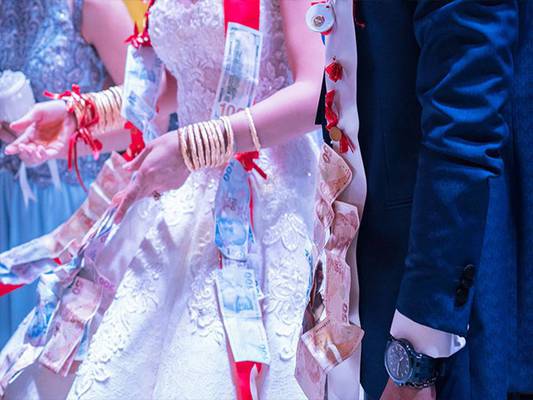
WITH A VISIT TO SZCZEPKOWO BOROWE
In search of sources of Easter traditions in our region and country, the students went to the Environmental Self-Help House in Szczepkowo Borowe. A group of young people was warmly welcomed by local therapists and class participants, who tried to provide young people with as much information as possible about the customs and traditions in their own homes. Representatives of the oldest generation talked about preparing for Christmas, i.e. the tradition of forty-day fasting, lime whitening of rooms, the preparation of dishes, the course of the following days of Christmas, starting with Palm Sunday. They pointed out that all the elements of the holidays, those that have survived to this day, but also those that have disappeared, have their symbolism, for example, the egg is a sign of a new life. They also mentioned old games and spending free time. The students learned that today the Whigus dyngus no longer resembles the old custom, where the maidens were even dipped in the river and in addition they did not really defend themselves against this, because it was to ensure their happiness and success. The next stage of the workshop was the Christmas decorations for each participant: palms and eggs. Although it was not an easy task, everyone enthusiastically accepted the challenge, because you could count on the friendly help of specialists who patiently explained and demonstrated the individual steps. After a few hours, everyone could admire the effects of their work. The participants took their decorations to their homes to celebrate this year’s holidays. Finally, the ladies prepared a surprise in the form of singing several folk songs and encouraged them to have fun together. Home atmosphere, refreshments, joint work and fun, a lot of laughter, conversations in which the difference in age did not play a role, caused that both groups decided to strengthen ties and continue cooperation. Thank you for accepting our "research" group, Mr. Ireneusz Kondrów, Mrs. Marzena Szmitkowska and ladies therapists: Janina Sadowska, Aleksandra Szymańska, Katarzyna Borkowska and ladies participants - representatives of the older generation, who as witnesses to cultivating tradition are the most valuable source of information for us.
Mariola Podolska-Maculewicz, project coordinator; Szkoła Podstawowa Nr 2 z Oddziałami integracyjnymi im. Michała Kajki w Nidzicy, Poland
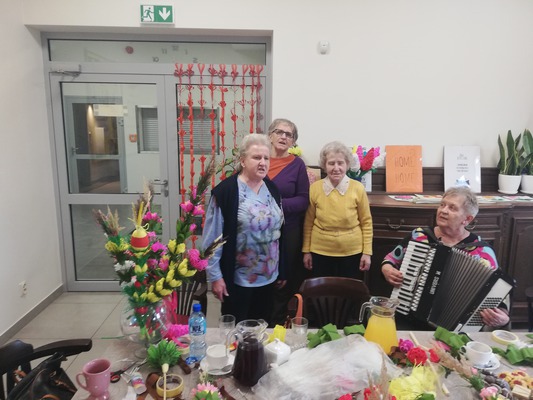
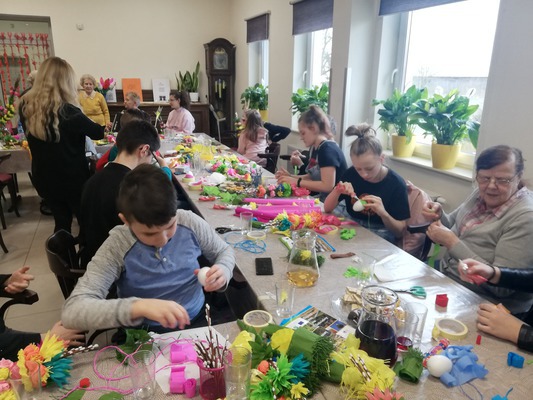
UCZESTNICY ERASMUS+ ‘FOLKLORICA’ Z DWÓJKI Z WIZYTĄ W SZCZEPKOWIE BOROWYM
W poszukiwaniu źródeł tradycji wielkanocnych w naszym regionie i kraju, uczniowie Dwójki udali się do Środowiskowego Domu Samopomocy (prowadzonego przez fundację ITAJ) w Szczepkowie Borowym. Grupa młodzieży została ciepło przyjęta przez miejscowe terapeutki i uczestniczki zajęć, które w bardzo przystępny sposób starały się przekazać młodym jak najwięcej informacji o zwyczajach i tradycjach we własnych domach. Przedstawicielki najstarszego pokolenia opowiadały o przygotowaniach do świąt, czyli o tradycji czterdziestodniowego postu, bieleniu wapnem pomieszczeń, szykowaniu potraw, przebiegu kolejnych dni świąt, począwszy od niedzieli palmowej. Zaznaczały, że wszystkie elementy świąt, te, które przetrwały do dziś, ale i te, które zanikły, mają swoją symbolikę, na przykład jajko to znak nowego życia. Wspominały również o dawnych zabawach i spędzaniu czasu wolnego. Uczniowie dowiedzieli się, że śmigus dyngus dziś nie przypomina już dawnego zwyczaju, gdzie panny były nawet zamaczane w rzece i w dodatku niespecjalnie się przed tym broniły, bo miało to zapewnić im szczęście i powodzenie. Następnym etapem warsztatu było własnoręczne wykonanie przez każdego uczestnika ozdób świątecznych: palmy i jajka. Mimo, że nie było to łatwe zadanie, wszyscy z zapałem podjęli wyzwanie, gdyż można było liczyć na życzliwą pomoc specjalistek, które cierpliwie objaśniały i demonstrowały poszczególne kroki. Po kilku godzinach każdy mógł podziwiać efekty swojej pracy. Zrobione przez siebie ozdoby uczestnicy zawieźli do domów, by uświetniły tegoroczne święta. Na koniec panie przygotowały niespodziankę w postaci odśpiewania kilku pieśni ludowych i zachęcały do wspólnej zabawy. Domowa atmosfera, poczęstunek, wspólna praca i zabawa, dużo śmiechu, rozmowy, w których różnica wieku nie grała roli, sprawiły, że obie strony zdecydowały zacieśnić więzi i kontynuować współpracę. Dziękujemy za przyjęcie naszej grupy „badawczej” panu Ireneuszowi Kondrówowi, pani Marzenie Szmitkowskiej oraz paniom terapeutkom: Janinie Sadowskiej, Aleksandrze Szymańskiej, Katarzynie Borkowskiej oraz paniom uczestniczkom - przedstawicielkom starszego pokolenia, które jako świadkowie kultywowania tradycji są dla nas najcenniejszym źródłem informacji.
Ewa Hinburg, nauczyciel; Szkoła Podstawowa Nr 2 z Oddziałami integracyjnymi im. Michała Kajki w Nidzicy, Poland
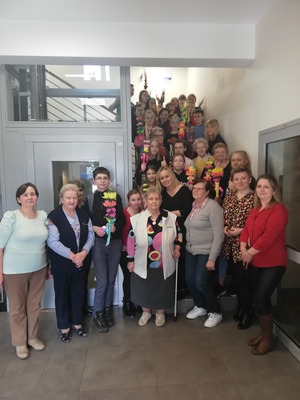
Masurian Wedding Preparations
The Erasmus+ ”Folklorica” group from class 6c is getting ready to stage "The Mazurian Wedding" at school, based on a script by Izabela Parecka, under the direction of Ewa Hinburg and Dorota Kosińska. The aim of the project is to learn about the traditions of the ceremonies and rituals in our region and to transfer the acquired knowledge in an attractive way to partner countries. The show preparation is a multi-stage work. Students began by searching historical information sources on rites or ceremonies. They got to know the wedding ceremony course , checked the participants' attire and the room preparation. The next stage is practicing diction, stage movement, songs, folk dances. Mrs. Iwona Nasiadka prepared the dance. It was also necessary to select the suitable folk music for the script. Soon the show premiere. We hope viewers will like it.
Mariola Podolska-Maculewicz, project coordinator, Szkoła Podstawowa Nr 2
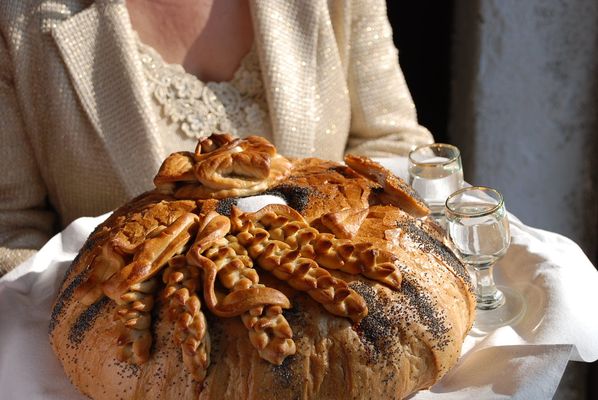
Wesele Mazurskie Przygotowania
Zespół Erasmus+ ‘Folklorica’ z klasy 6c przygotowuje się do wystawienia na szkolnej scenie „Wesela Mazurskiego” na podstawie scenariusza pani Izabeli Pareckiej, pod kierunkiem pań: Ewy Hinburg i Doroty Kosińskiej. Celem całego przedsięwzięcia jest poznanie tradycji związanych z ceremoniami i obrzędami w naszym regionie oraz przekazanie zaczerpniętej wiedzy w przystępny i atrakcyjny sposób krajom partnerskim. Przygotowanie przedstawienia to praca wieloetapowa. Uczniowie zaczęli od poszukiwań w dostępnych źródłach historycznych informacji dotyczących obrzędów i ceremonii. Poznali przebieg uroczystości weselnej, sprawdzili jak wyglądał ubiór uczestników oraz przygotowanie sali. Następny etap to ćwiczenia dykcji, ruchu scenicznego, pieśni i tańców ludowych. W przygotowaniu tańca pomogła pani Iwona Nasiadka. Należało też dobrać do scenariusza odpowiednią muzykę ludową. Wkrótce premiera naszego spektaklu. Mamy nadzieję, że spodoba się widzom.
Ewa Hinburg, teacher, Szkoła Podstawowa Nr 2 im. Michała Kajki w Nidzicy
Traditions and Ceremonies in Spain
Spains-presentation-16th-March.pdf
Guide-for-online-presentation.pdf
Folklorica-Erasmus-Project.pdf
February-Article.docx
Traditions and Ceremonies in Cyprus
Traditional-Cypriot-wedding-through-the-years.pptx
The-custom-of-the-Flood-has-its-roots.pptx
Easter Customs in Cyprus.pptx
cypriot-tasks-cypriot-flood-festival.docx
Traditions and Ceremonies in Lithuania
st.johns.day.erasmus-2.pptx
tasks-2.docx
the-answers.docx